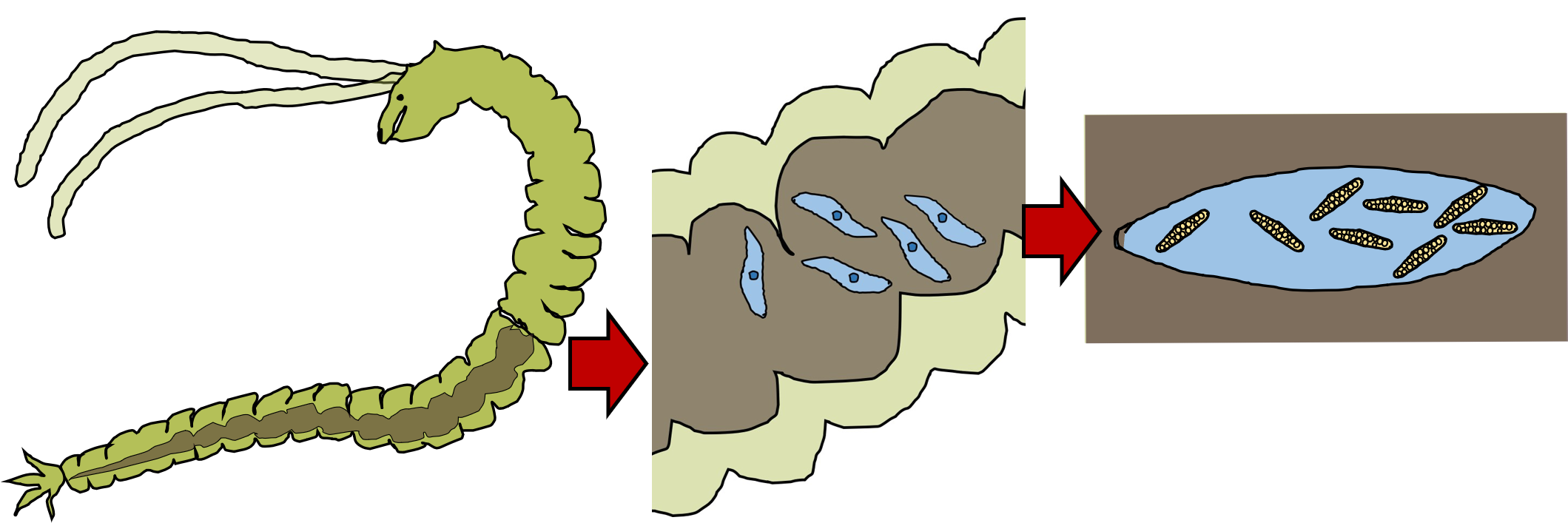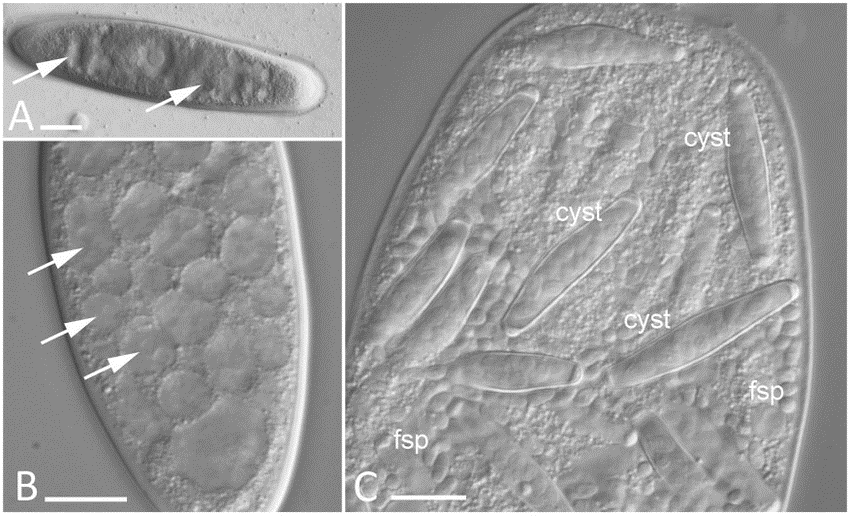Cover image: Metchnikovella incurvata, a parasite of a bristle worm infecting gregarine. Picture from Galindo et al. 2018, https://doi.org/10.1093/gbe/evy205
For this month’s group, I want to present you another group of organisms I am currently working with in my postdoc project PolyPro3 here at NHM Oslo. This is a peculiar group of microsporidian parasites called Metchnikovellidae. But first, before jumping into the world of metchnikovellids, let’s talk a little about microsporidians, who are they and why are they important.
Microsporidia
Microsporidia are protists that live as parasites of animals and sometimes other protists, such as gregarines. Microsporidia have been known to science for about 150 years, and approximately 1600 species in 187 genera have been described to this day. These parasites play important roles in nature by and in some cases, their infections cause significant economic damage for example in honeybee, salmon, and shrimp industries.
Microsporidians have adapted to their parasitic life style so well that over evolutionary time, they have lost significant parts of their genomes and proteomes, making them completely dependent on their hosts metabolically! This reduction makes them really stand out from other eukaryotes and in fact, microsporidia possess the most reduced eukaryotic genomes known. The smallest one found to date is from a species called Encephalitozoon intestinalis. With only 2.3 Mb in size it is half the size of the E. coli genome and over a thousand times smaller than the human genome!
Metchnikovellidae
Metchnikovellids are parasites of other protists known as marine gregarines. Gregarines that host them are themselves symbionts of marine worms, mainly polychaetes. This fascinating system is called hyperparasititsm (Figure 1). To this day, some 30 metchinovellid species have been described, most of them from single host gregarines. In reality, this group has received very little research interest and their true diversity is likely much higher. One system where there are actually multiple different species of metchnikovellids is the one that I’m studying, the sand tube worm (Pygospio elegans) – gregarine – metchikovellid tripartite symbiosis. The sand tube worm is host to at least two gregarine species, both of which can host at least two metchnikovellid species.

It is yet unclear how this hyperparasitism affects the host species in the system. Metchnikovellids are expected to be lethal to their gregarine hosts due to the fact that they cause deformations and might obstruct their hosts in many ways from reaching maturity and reproduction. It is therefore likely that they could effectively regulate gregarine populations within the superhost, the sand tube worm. As we also do not yet know if the gregarines are harmful to their hosts or not, this system is particularly interesting to study from the host-parasite evolution point of view. In my research, I’m looking at how common this kind of hyperparasitism is in nature and hope resolve the mystery of this symbiosis in the future.
References
- Galindo, L.J. et al. 2018. Evolutionary genomics of Metchnikovella incurvata (Metchnikovellidae): An early branching microsporidium. Genome Biol Evol., 10(10):2736-2748. doi: 10.1093/gbe/evy205
- Whelan, T.A. & Fast, N.M. 2023. Microsporidia. Curr Biol., 33(18):R936-R938. doi: 10.1016/j.cub.2023.06.076.
- Frolova, E.V., Paskerova, G.G., Smirnov, A.V. & Nassonova, E.S. 2023. Diversity, Distribution, and Development of Hyperparasitic Microsporidia in Gregarines within One Super-Host. Microorganisms, 11(1):152. doi: 10.3390/microorganisms11010152.
![]()
